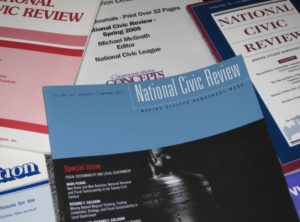 At a recent gathering of local government officials and civic activists from around the world, I was approached by the founder of an NGO for young “civic entrepreneurs” in Budapest, Hungary. He told me he had reading the National Civic Review for years. In fact, some of the ideas that inspired him years ago when he found the NGO, he’d first encountered in the Review.
At a recent gathering of local government officials and civic activists from around the world, I was approached by the founder of an NGO for young “civic entrepreneurs” in Budapest, Hungary. He told me he had reading the National Civic Review for years. In fact, some of the ideas that inspired him years ago when he found the NGO, he’d first encountered in the Review.
For the editor of a 105-year-old civic affairs journal, nothing could be more gratifying than to hear that an article or issue has influenced someone in that way. It’s a reason to get up in the morning. The National Civic Review features essays, articles, reports, interviews and reviews on just about every angle and dimension of community-based civic engagement.
There isn’t another publication quite like it. There are heavily footnoted scholarly journals written in an academic language barely decipherable to the lay reader. There are association newsletters or organizational websites with snippets of information or brief updates and program descriptions. But no publications I know of with quite the same commitment to reaching a broad cross section of civic doers and thinkers with in depth articles and clear, readable prose.
The style and content of the journal has changed dramatically over the years. The first issue of the Review was published in January of 1912 in response to what the original editor described as a “widely expressed desire for a thoughtful discussion of city problems and a careful chronicle of municipal events.” That editorial comment might seem implausible by contemporary notions of what readers find interesting, but city governments were more “interesting” in those years, in the sense of being corrupt, dysfunctional and populated by a cast of colorful scoundrels.
The Review covered cities in a far more sober and comprehensive fashion than the muckraking glossies of the day. Historian Charles Austin Beard once listed a selection of Review topics from the early years: “bakeshop inspection, billboards, budgets, building construction, charters and ordinances, child welfare, city planning, civil service, courts, debt, employment bureaus, excess condemnation, finance, fire service, food and drug regulations, hospitals, housing, insurance, labor conditions, libraries, light and power plants, markets, milk supply, municipal accounting…” and on and on.
In the early twentieth century, the Review served as a sounding board for the League’s various models, charters and research projects. In 1915, for example, the Review published the “Model City Charter and Municipal Home Rule,” a document that introduced the country to the “city council/city manager” form of government, today the most commonly used model for local government in the U.S.
In the early 1990s, the Review was a leading outlet for new ideas on civic engagement, community building and collaborative problems solving. Common Cause founder John Gardner first made his pitch for a “national renewal” movement in the Review. Robert Putnam laid out his ideas about the value of “social capital” and voluntary associations in a Review article years before the publications of his breakout book, Bowling Alone.
The look and feel of the Review has changed over the years—different sizes and different shapes, so has the editorial emphasis. In recent years, the journal has published articles and special issues on topic such as healthy communities, racial equity, education, environmental sustainability and community-based strategic planning and democratic governance. But essentially the journal remains true to its original mission, to promote innovative ideas on the connection between local government, civic engagement and grassroots, community-based problem-solving.



